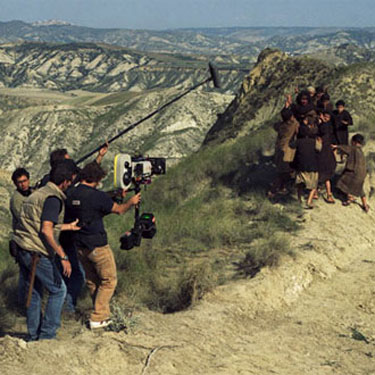|
 On location of On location of
ROME, ITALY: A location sound recordist with a passionate, audiophile approach to his craft, Maurizio Argentieri found the audio interface of his dreams two years ago when he read about Metric Halo’s Mobile IO 2882+DSP on the Internet. An audio engineer in the Italian film industry for over 15 years, the Rome native’s recent work can be heard in Mel Gibson’s “The Passion of the Christ” as well as Mike Barker’s upcoming "A Good Woman" and Michael Apted’s much anticipated HBO series, “Rome.”
Argentieri uses Metric Halo’s MIO 2882+ DSP and Spectrafoo metering software with MOTU’s Digital Performer as the host application on his Powerbook G4. “I chose the Metric Halo interface because it was the only one to use Firewire bus power,” he explains. “In my application this is a very important characteristic, because we do not always have electrical power.”
He continues, “My approach to audio recording is much closer to audiophile people than the professional category of audio engineers. In my opinion, the MIO has the best sounding converters of the category. That is the main reason that gave me the push to buy it.”
Using his high-end, Metric Halo-based recording setup, says Argentieri, he can hand the film editor a 16-bit CD of the rough dialog mix at the end of each workday. “I've always dreamed of an instrument capable of recording ready-to-use audio files on the set. I know there are machines on the market capable of recording audio files, but if I have to use a hard disc recorder I prefer to do so using a computer with a host application that gives me the possibility to have plug-ins at my disposal.”
In the past, he used a pair of traditional location recorders to capture eight tracks, but “suffered under their weight and bulk,” he says. “Today, with my MIO, I only have my CPU, interface, and the rack with my preamplifiers, giving me all the power I need on the set, including EQ, compressors, delay, and perhaps the most powerful metering software in the world, SpectraFoo.”
The Italian engineer believes that the sound of any movie is, for the most part, built on location. “The biggest responsibility of our work is to remain loyal to the desires and needs of the director and to insure that everything recorded on the set is exported intact. So, I don't limit the sound recording to the dialog but include every ‘one-time event’ that happens in front of the camera.”
To achieve that coverage, Argentieri typically utilizes a centrally placed mono mic for the dialog with a separate setup picking up the stereo soundstage. On a multi-camera shoot where booms cannot be used he will also record individual radio mics to separate channels to give the dialog editor more to work with. “I absolutely need an interface that gives me the possibility of at least eight channels,” he observes. “That is the reason I chose the MIO for set work.”
He offers “The Passion” as an example. “From an audio standpoint, this film was extremely difficult in that it was filmed using at least three cameras at the same time, necessitating the use of radio mics, but so much went on apart from the dialog. The screaming crowds made the use of stereo mics simultaneously a necessity. In this situation, I used the MIO a lot, because I needed many channels.”
In addition to his Metric Halo equipment, Argentieri’s uniquely audiophile approach also includes Manley and Millennia Media mic preamps -- and he insists on making his own silver audio cables and screened power cables. “I believe that high-end cables, the best mic preamp, powering all the equipment respecting the electrical phase, and using shielded power cords are all elements that, summed together, will produce a big difference. I know that is not the normal setup for the movie sound recordist but I love that sound and I will follow that forever.” |